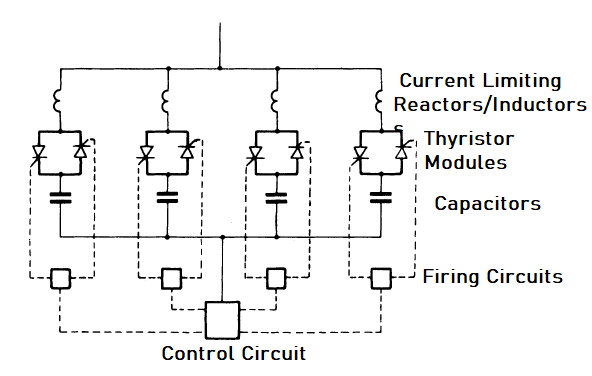Flexible AC Transmission Systems (FACTS) can be described as AC transmission systems incorporating power electronic-based controllers and other static controllers to boost controllability and increase power transfer capability. FACTS equipment that provides control of one or more of the parameters of an electrical network is often referred to as a FACTS controller. FACTS devices may be used to maximize the capacity of new and existing Transmission and Distribution networks. The advantages of the installation of FACTS controllers in transmission and distribution networks include:
- Steady-state and dynamic reactive power compensation and voltage regulation.
- Steady-state and dynamic stability enhancement.
- Increasing power transfer capability of existing assets.
- Reduced fault current.
- Reduced transmission losses.
- Improving power quality.
An example of FACTS device is the static var compensator (SVC). A traditional SVC device consists of a capacitor to generate vars and an inductor to absorb vars. To provide operation in both the generation and absorption modes, both elements must be used; at least one of them must be a fast variable.

SVCs ability to quickly respond to changes in reactive power loading has resulted in their widespread use as elements in power transmission systems. They have been used to deal with voltage dips, fluctuations, flicker and unbalance. Such compensators are formed from a parallel connection of capacitors and thyristor-controlled reactors. Thyristor control varies the lagging reactive current so that the compensator can either generate capacitive vars to support the voltage or generate lagging vars in order to reduce the voltage. Thyristor control equipment inevitably generates its own harmonics which are very sensitive to the thyristor firing angle delay. The equipment capacitor arms are often split into sub units to act as the necessary harmonic filters and sometimes the capacitors are also thyristor switched.

Figure 1.1: One phase of a thyristor-switched capacitor compensator.
Another type of FACTS device is the STATCOM (acronym for static compensator). STATCOM is a voltage sourced converter which uses power electronic switches (Gate Turn Off Thyristors (GTOs)) to derive an approximately sinusoidal output voltage from a DC source (typically a capacitor). It is coupled to the system being compensated via an inductive impedance of low per unit value, and behaves very much in a similar way to a synchronous compensator, but with a vastly faster response. It has a natural tendency to compensate for changes in system voltage, and can do so very fast. Unlike a constant impedance device such as a capacitor or inductor whose output current will decrease with voltage, it will continue to generate its maximum output current even at low system voltages.
STATCOM device is an option for compensating voltage dips, surges, unbalance and flicker and generally takes less space than an SVC, but as a more sophisticated device, it is more expensive, power for power, additionally, it doesn’t have the proven reliability for an SVC. Nonetheless many of these devices have already been installed in transmission schemes to provide reactive compensation.
Technically, by replacing the storage capacitor with a chemical storage system or even a super-conducting storage device, the STATCOM provides the possibility of becoming a fast response system energy store.
Related articles:
Recommended: The Ultimate Guide to Electrical Maintenance
- Common Terms Used When Describing Power Quality Problems
- Causes of Power System Disturbances & Corrective Measures
- Sources of Power Quality Problems
- Protective Relays: Function, Features & Operation
- Testing & Commissioning Protective Schemes
- Overvoltage Protection Techniques & Equipment
- AC to AC Power Converters with Intermediate DC Link: Types, Features & Applications
- How to calculate the Power Factor Correction


Leave a Reply
You must be logged in to post a comment.